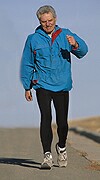- Skip Storing This Everyday Product in the Fridge Door
- Green Tea + B3 Pairing May Boost Brain Health
- Navigating Your Midlife Crisis: Embracing New Possibilities
- City Raccoons Showing Signs of Domestication
- Mapping the Exposome: Science Broadens Focus to Environmental Disease Triggers
- One Week Less on Social Media Linked to Better Mental Health
- Your Brain Changes in Stages as You Age, Study Finds
- Some Suicide Victims Show No Typical Warning Signs, Study Finds
- ByHeart Formula Faces Lawsuits After Babies Sickened With Botulism
- Switch to Vegan Diet Could Cut Your Greenhouse Gas Emissions in Half
Any Exercise Is Good, But Higher-Intensity May Be Better


For people who are obese and sedentary, any exercise can help trim belly fat, but it may take a bit more effort to get other health benefits, a new study suggests.
Researchers found that when they got middle-aged, obese adults regularly moving — even with a half-hour of slow walking — it helped them shed a little bit of weight and a couple of inches from their waistlines.
However, it took higher-intensity exercise to lower people’s blood sugar levels — which, over the long term, might reduce their risk of type 2 diabetes.
While “higher-intensity” might sound daunting, experts stressed that it’s within reason for even dedicated couch potatoes.
“The people in this study were middle-aged, sedentary and abdominally obese,” said lead researcher Robert Ross, an exercise physiologist at Queen’s University in Ontario, Canada. “We didn’t have them running. ‘High-intensity’ just meant walking briskly on a treadmill,” he said.
“It was very doable,” added Ross, who reported his team’s findings in the March 3 edition of Annals of Internal Medicine.
A researcher who reviewed the study called it “beautiful work.”
And, the results may help alter current exercise guidelines, said Dr. Timothy Church, a professor of preventive medicine at Pennington Biomedical Research Center in Baton Rouge, La.
That’s because there’s been so little good research on exercise intensity, and “this study fills a major gap,” Church said. “It shows that intensity does matter.”
Besides the benefits for blood sugar, Church noted, study participants who exercised at a higher intensity also saw a bigger improvement in their cardiovascular fitness — which is an important factor in the risk of dying from heart disease or stroke.
For the study, Ross and colleagues recruited 300 people in their 40s and 50s who were abdominally obese and got little to no regular exercise. They then randomly assigned everyone to either a “control” group that remained sedentary, or one of three exercise groups.
All of the exercisers came to five supervised sessions a week, for six months. One group did a low amount of low-intensity activity (about a half-hour of slow walking); another group stuck with the low-intensity regimen, but for a longer period (averaging an hour per session); and a fourth got higher-intensity exercise — namely, faster-paced walking.
Those fast walkers burned the same number of calories as their slower-paced peers who walked for an hour — but they did it in 40 minutes.
After six months, the investigators found, all three exercise groups had lost a small amount of weight and one or two inches from their waistlines, on average. But only the high-intensity group showed an improvement in blood sugar levels.
“Will this [regimen], if performed for years, lower the risk of type 2 diabetes?” Ross said. “We don’t know.”
But, he added, “I like the chances.”
And why would higher-intensity be better for blood sugar control? According to Church, it’s likely related to muscle — which is the biggest consumer of blood sugar in the body; put simply, higher-intensity exercise may improve the muscles’ ability to pull sugar from the blood.
“Blood sugar control is not just about body fat,” Church said.
In his own research, Church has found that combining aerobic exercise and strength training is better than either alone for improving blood sugar levels in people who already have diabetes.
According to Ross, the new findings are “good news” for people who are overweight and sedentary — which describes a huge swath of North Americans, he noted.
“This means you have options,” Ross said. “If your primary goal is to lose some weight, all of these exercise regimens worked. If you want to better manage blood sugar, higher-intensity is better. If you want to improve cardiovascular fitness, all of these worked — but higher-intensity was optimal.”
And if regular exercise of any kind sounds daunting, you do not have to jump right into 40 minutes of brisk walking, five days a week, Church pointed out.
“You can build up to it,” he said. “The most important step is just getting off the couch.”
More information
The U.S. Centers for Disease Control and Prevention has advice on increasing your physical activity.
Source: HealthDay
Copyright © 2025 HealthDay. All rights reserved.










